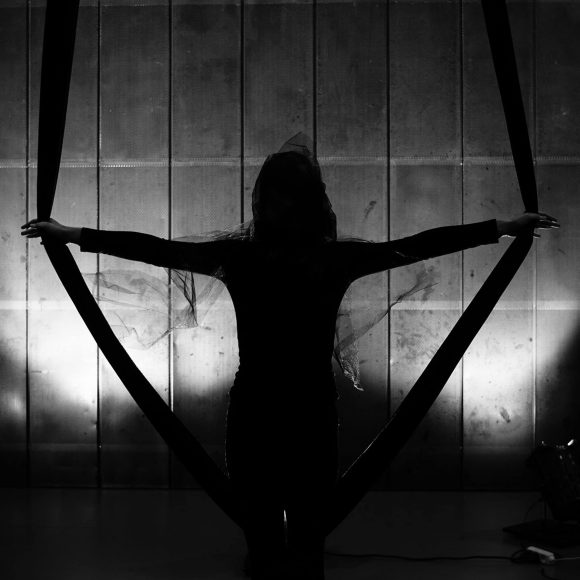
Ethered and Tethered: A Liminal Space (CU Boulder Theater & Dance/Facebook)
Ethered and Tethered: A Liminal Space, an MFA dance concert created and choreographed by CU Boulder student Danielle Garrison, came to life on the evenings of Jan. 25 and 26 at Irey Theatre. Through a wide array of movements and media, the interactive event asked its attendees to grapple with the helplessness of grief and the intangibility of information.
When Garrison came across an article in the Toulousian newspaper, “La Dépêche” last year during her Fulbright experience in France, she was shaken to her core. One person, the article said, commits suicide every hour in France.
“There was something about that story,” Garrison said. “The intangibility, the ongoingness in terms of time, the unknown of who or where or when specifically — this constant question of why, who, what, where and how am I responsible for that, or am I not?”
The show encouraged audience participation due to its unique setup. At the ticket booth, audience members were given a map of the space, which served as a guide.
“I really want the audience to have a kinesthetic or tactile experience,” Garrison said. We all are bringing something together as a cast, and then the audience is completing that experience.”
Even the lobby of the Irey Theatre became grounds for interactive art. In one corner, a video camera recorded people’s reactions to newspaper clippings — including the suicide article from “La Dépêche” as well as the most recent issue of the “Boulder Weekly”. These recordings were broadcasted on a screen inside the theatre, which were juxtaposed with the somber mood.
Going into the space, attendees were confronted by the writhing bodies of actors with grief-stricken expressions. In one section, a half-nude woman methodically laid papier-mâché strips on the body of another woman lying supine, chanting unintelligibly. In another area, a woman sat behind two sheets of transparent plastic emulating a mirror. She reached her hands out desperately, calling on the audience to reach out as well. Toward the back of the theatre hung a sheet of black fabric and a seemingly disembodied arm jutted out from it, the hand curling and asking to be held. Holding it, attendees wondered who this person was and what an exchange so intimate and yet so devoid of context could possibly mean.
One back corner of the room was blocked off by a wall. Within the room sat a newspaper-clogged toilet in front of a microphone. Audience members sat down, leaning forward to tell a story. The narrative began to lose itself in the dark atmosphere of the room, and the audio echoes out, disembodied, into the lobby.
Garrison was influenced by France’s history with the circus, evidenced in the silk and aerial dancing throughout the installation. At times, the aerial movements of the dancers resembled something menacing — like strangulation. The audience members latched onto some of the silks themselves. Sitting in the black cloth like it’s a hammock, one man whipped himself wildly back and forth. Next to him, one audience member kneeled and pushed their partner, lying in the fabric, gently to and fro.
Being physically present at this haunting, genre-defying show brought together the titular themes of “ethered” and “tethered.” Screens and sounds loomed intangibly over attendees and they projected their own sounds and images throughout the theatre. At the same time, audience members touched actors’ hands and moved with their own bodies. The show presented the irresolvable paradox of the postmodern world: we are ethered through media and tethered through our bodies, neither here nor there.
“I’m really interested in this idea of apathy … there’s so much information available to me and yet the humans behind these global stories,” Garrison said. “What do I do about them? Do I just ingest them or consume them, do I ignore them, or do I engage with them?”
Contact CU Independent Arts Writer Drew Korschun at drew.korschun@colorado.edu.
